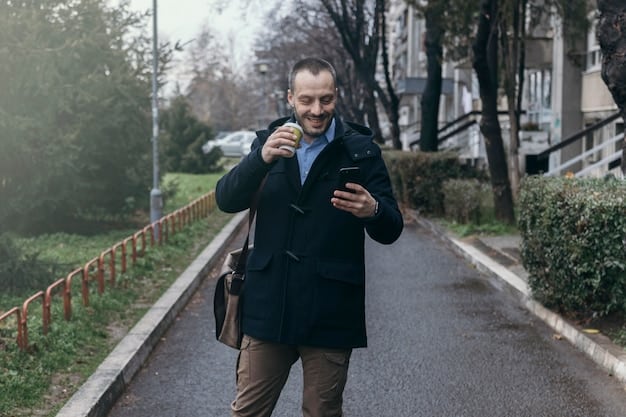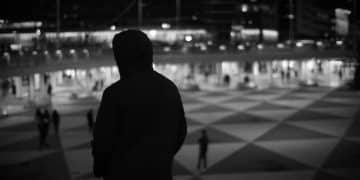Personal Safety Tips: Stay Safe Walking Alone at Night

Personal safety tips are crucial for staying safe while walking alone at night, encompassing awareness of surroundings, using well-lit routes, and carrying personal safety devices.
Walking alone at night can be risky, but being prepared and aware can significantly reduce potential dangers. This article provides essential personal safety tips: staying safe while walking alone at night, helping you feel more secure.
Be Aware of Your Surroundings
One of the most effective ways to enhance your safety while walking alone at night is to maintain a heightened awareness of your surroundings. This involves paying attention to the people around you, the environment, and any potential hazards that may arise. By being vigilant, you can proactively identify and avoid risky situations.
Avoid Distractions
Distractions can severely compromise your awareness. Put your phone away and avoid using headphones, which can limit your ability to hear approaching dangers. Focus on what’s happening around you.
Trust Your Instincts
If a situation or person makes you feel uneasy, trust your gut. It’s better to be cautious than to ignore a feeling of unease and potentially put yourself at risk.

Remember, personal safety is a continuous practice that requires adaptability and presence of mind. Being alert is your first line of defense.
- Stay off your phone to minimize distractions.
- Trust your intuition and avoid areas that feel unsafe.
- Pay attention to the behavior of people nearby.
Remaining aware and alert is a crucial deterrent and a safety measure that can significantly decrease your vulnerability while walking alone at night.
Plan Your Route in Advance
Careful planning can greatly reduce risks when walking alone at night. Choosing the safest, most well-lit, and populated routes can deter potential threats and make your walk more secure.
Opt for Well-Lit Streets
Poorly lit streets can provide cover for potential assailants. Choose routes that are well-lit with streetlights and avoid dark alleys or secluded paths.
Stick to Populated Areas
Walking through populated areas increases your visibility and the likelihood of assistance if needed. Avoid shortcuts through parks or vacant lots, especially at night.
Planning your route doesn’t only include street choices; it also means communicating that route to someone you trust, allowing you to have additional security.
By proactively planning your route, you equip yourself with knowledge and tools to navigate the night confidently and safely.

- Always inform someone of your route and estimated time of arrival.
- Use map apps to identify well-lit and frequently traveled streets.
- Avoid shortcuts through unlit or deserted areas.
Planning your route enhances your overall personal safety strategy and demonstrates proactive preparation.
Carry Personal Safety Devices
Equipping yourself with personal safety devices can provide a crucial edge in unexpected situations. These tools are designed to deter attackers, attract attention, or quickly call for help.
Personal Alarms
A personal alarm emits a loud sound that can scare off potential attackers and alert people nearby. Ensure it is easily accessible, such as on a keychain or in a pocket.
Flashlights
A bright flashlight can disorient an assailant and provide better visibility in dark areas. It can also be used to signal for help if needed.
Consider Self-Defense Tools
If legal in your area, consider carrying pepper spray or a personal safety baton. Ensure you are trained in their proper use and understand local laws regarding self-defense.
Having these devices readily available can significantly enhance your ability to protect yourself.
The availability of these devices can make a substantial difference in unexpected or threatening situations.
- Carry a personal alarm to deter attackers and attract attention.
- Use a flashlight to improve visibility and disorient aggressors.
- Ensure you are trained and compliant with local laws if carrying self-defense tools.
Personal safety devices are valuable additions to your overall strategy for walking alone at night, providing tangible means to defend yourself and call for aid.
Dress Appropriately and Confidently
Your attire and demeanor can influence how you are perceived by others and affect your overall safety. Dressing practically and projecting confidence can deter potential threats.
Wear Comfortable Shoes
Wearing comfortable shoes enables you to walk quickly or run if necessary. Avoid footwear that restricts your movement, such as high heels or heavy boots.
Avoid Wearing Expensive Jewelry
Expensive jewelry can make you a target for theft. Opt for simpler accessories or none at all when walking alone at night.
Projecting confidence is just as crucial as your physical appearance. This confidence can serve as another layer of protection.
Dressing appropriately and confidently contributes to your overall personal safety, sending a message of preparedness and strength.
- Wear comfortable shoes for ease of movement and escape.
- Avoid displaying expensive jewelry to reduce the risk of theft.
- Project confidence through posture and eye contact.
Your dress and how you carry yourself can collectively enhance your safety strategy, signaling alertness and self-assurance.
Use a Buddy System When Possible
Walking with a friend or companion is one of the simplest and most effective ways to enhance your safety while walking alone at night. A buddy system provides mutual support, increased visibility, and a deterrent to potential threats.
Walking with a Friend
There is safety in numbers. Walking with someone reduces the likelihood of being targeted and provides assistance in case of an emergency.
Join a Walking Group
Participating in a walking group can provide a consistent and supportive environment for evening strolls. Check community centers or local organizations for available groups.
If walking with a friend isn’t possible, exploring virtual buddy systems can offer similar benefits.
The buddy system significantly enhances your safety, providing companionship and mutual support to deter potential threats.
- Find a friend or family member to walk with regularly.
- Join a local walking group for consistent companionship.
- Explore virtual buddy systems for when physical accompaniment isn’t possible.
By implementing a buddy system, you increase your visibility and gain the advantage of shared vigilance, making your nighttime walks significantly safer.
Learn Basic Self-Defense Techniques
Knowing basic self-defense techniques can empower you to protect yourself effectively in a dangerous situation. While not a replacement for professional training, these techniques can provide a crucial response option if threatened.
Attend a Self-Defense Class
A formal self-defense class teaches essential skills, including strikes, blocks, and escape maneuvers. These classes often include situational awareness and risk assessment strategies.
Practice Basic Moves
Regularly practice moves such as a strong stance, assertive voice projection, and defensive blocks. Muscle memory can prove invaluable in a high-stress encounter.
Beyond the physical techniques, understanding de-escalation strategies can further enhance your overall preparedness.
Learning basic self-defense techniques equips you with essential skills to protect yourself and enhances your confidence in handling threatening situations.
- Enroll in a self-defense class to gain practical skills.
- Practice basic moves regularly to build muscle memory.
- Learn de-escalation strategies to avoid physical confrontation when possible.
Having these techniques in your repertoire provides a valuable layer of defense, increasing your ability to respond effectively and protect yourself from harm.
Trust and Utilize Available Resources
Leveraging available resources, such as emergency services, community support, and technology, is essential for enhancing your personal safety while walking alone at night. Knowing how and when to use these resources can make a critical difference.
Emergency Services
Keep emergency numbers readily available on your phone and know how to quickly contact local law enforcement if needed. Familiarize yourself with the emergency response protocols in your area.
Community Support
Connect with local neighborhood watch groups and community safety initiatives. These resources can provide valuable information about local risks and safety measures.
Technology has also provided numerous tools to enhance your safety.
Trusting and utilizing available resources empowers you with additional layers of support and ensures you are never truly alone.
- Keep emergency numbers easily accessible on your phone.
- Engage with neighborhood watch groups and community safety initiatives.
- Utilize safety apps that can alert contacts or summon help.
By staying informed and connected, you enhance your ability to respond effectively to emergencies and contribute to a safer community environment.
| Key Point | Brief Description |
|---|---|
| 👀 Stay Alert | Keep your eyes open and minimize distractions to stay aware of your surroundings. |
| 🔦 Use Well-Lit Paths | Stick to streets that have good lighting to avoid dark spots and potential dangers. |
| 🚨 Carry Safety Devices | Equip yourself with personal alarms or pepper spray to deter potential attackers. |
| 🚶 Find a Buddy | Walk with a friend or join a walking group to increase safety in numbers. |
FAQ
▼
Before heading out, always plan your route. Choose well-lit, populated streets, and let someone know where you’re going and when you expect to be back. This ensures someone knows your whereabouts in case of an emergency.
▼
Yes, personal alarms are quite effective. They emit a loud, attention-grabbing sound that can startle potential attackers and alert people nearby. Make sure it’s easily accessible for quick activation.
▼
Trusting your instincts is crucial. If a situation or person makes you feel uneasy, it’s always best to remove yourself from the situation. Your intuition can be a powerful tool in identifying potential threats.
▼
Wear comfortable shoes that allow you to move quickly. Avoid heels or restrictive footwear. The ability to run or walk briskly is essential for your safety in potentially dangerous situations.
▼
Yes, minimize phone usage. Distractions can greatly reduce your awareness of surroundings. If you need to use your phone, stop in a well-lit and safe area before doing so, then immediately resume your alert walk.
Conclusion
Staying safe while walking alone at night requires awareness, preparation, and the right tools. By implementing these personal safety tips: staying safe while walking alone at night, you can significantly reduce risks and feel more confident as you navigate the night.





